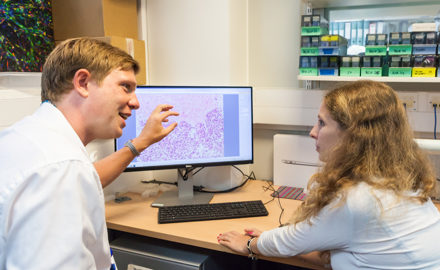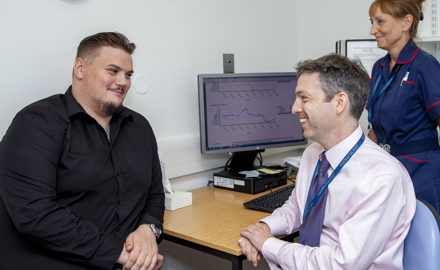Dr Cate Wight: Doctor and patient
Dr Cate Wight is a histopathologist working in Kent. She has over 20 years’ experience in pathology. Here she reflects on how her personal experience of being diagnosed with cancer has affected her medical practice.
I first thought of becoming a doctor as a young teenager. I became more determined when a teacher thought I might make a nurse but not a doctor. At 16, I was diagnosed with Ewing’s sarcoma – a type of cancer – and had to undergo gruelling radiotherapy and chemotherapy. Despite this, the orthopaedic surgeon I saw encouraged my ambition to become a doctor. This helped drive me to gain a place at Aberdeen Medical School.
During my studies, the cancer returned. I underwent a disarticulation amputation from the hip and took a year off for preventive chemotherapy. At the end of second year, I discovered pathology. To me, pathology – and especially histopathology – provided the logic to explain diseases and the symptoms patients experience. It still does.
I graduated in 1993. After house officer jobs and specialty training in Sheffield and Nottingham, I gained my MRCPath and took up a consultant post at Path Links in Lincoln. I became particularly interested in improving patients’ experiences of diagnosis. I learnt a lot about lean and continuous quality improvement techniques and how they can improve the efficiency and quality of cellular pathology.
Working with the team, we closely reviewed the whole process from patient to report and found ways to share results with patients faster. This was a real success, and often built on quite simple changes, such as colour-coding trays of slides for quick identification, or working with porters to speed up the transfer of biopsies.
In 2008 – during a day of reporting breast biopsies for a multidisciplinary team meeting – I attended a breast clinic for a check-up. My sister, who had been diagnosed with breast cancer aged 39, had pestered me to go. There was nothing on clinical examination but, after a mammogram, I was taken for an ultrasound. Immediately I knew they had found something. There was a cancerous mass, which I was told looked malignant, and a biopsy was carried out.
This experience – as patient and pathologist – has renewed my determination to embed what I’ve learnt to improve the systems that support diagnosis and treatment. I’m passionate about making changes that result in positive differences to patients.
Waiting for my results was incredibly difficult. I had patient worries – I was anxious about my long-term health, the time it would take to recover and financial worries. My husband and I also had three children aged 10, 12 and 14 and had to decide whether to tell them. As a pathologist I had other questions too, about the type of tumour I had, how fast it might grow and how treatable it would be.
At the results clinic, a few days later, I was told I had a grade 2 invasive ductal carcinoma – the most common type of breast cancer. I decided to have a mastectomy as I didn’t want radiotherapy again. As a patient, I really appreciated the warm and supportive care I was given, particularly from the breast care nurses.
In retrospect, I went back to work far too early – after just eight weeks – and I found reporting breast biopsies very difficult, as I found it hard to emotionally detach myself from the patients.
After several years I came to see it as a privilege to be a breast pathologist: by doing my job well I could help other patients experiencing breast cancer. This year, I was again diagnosed with breast cancer. Although anxious, I was more annoyed to have my life disrupted again: I’d applied for another consultant post at University Hospital Coventry and Warwickshire – a centre of excellence for digital pathology – and I didn’t want cancer to mean I had to withdraw my application. The biopsy showed I had the same type of tumour as before.
Again, I opted for a mastectomy, though I didn’t avoid radiotherapy this time as there was more than one tumour. I’m fortunate the cancer was detected and diagnosed early, which increases the chance of successful treatment. I’ve been able to get back to work and get on with my life.
This experience – as patient and pathologist – has renewed my determination to embed what I’ve learnt to improve the systems that support diagnosis and treatment. I’m passionate about making changes that result in positive differences to patients. Once a patient knows what they’re up against they can more easily find the strength to deal with it. From my experience, it’s the time of uncertainty that’s the hardest. I’m determined to make that time as short as possible.
Explore more stories from our Annual Report



